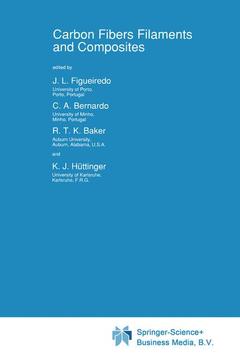Carbon Fibers Filaments and Composites, 1990 NATO Science Series E: Series, Vol. 177
Langue : Anglais
Coordonnateurs : Figueiredo J.L., Bernardo Carlos A., Baker R.T.K., Hüttinger K.J.

Conventional synthetic materials, like metals, ceramics or glass, are usually isotropic substances, and their suitability for structural applications is achieved by morphological design and combination in the macroscopic scale. However, in modem engineering this is often not acceptable. As an alternative, the use of non-homogeneous, anisotropic materials, with significant stiffness and strength only in the directions these mechanical properties are really needed, can lead to enormous material (and weight) savings. This is the case of multiphase systems called composite materials. In these composites, different material parts are added and arranged geometrically, under clearly designed and controlled conditions. Usually, a structure of fibers provides strength and stiffness and a matrix helds them together, whilst providing the geometric form. Carbon fibers are among the high-performance fibers employed in these advanced structural composites, which are profoundly changing many of today's high technology industries. New research and development challenges in this area include upgrading the manufacturing process of fibers and composites, in order to improve characteristics and reduce costs, and modifying the interfacial properties between fibers and matrix, to guarantee better mechanical properties. The interdisciplinary nature of this "new frontier" is obvious, involving chemistry, materials science, chemical and mechanical engineering. Other topics, which more often are treated separately, are also important for the understanding of the processes of fiber production. Carbon filaments is one such topic, as the study of their mechanisms of nucleation and growth is clearly quite relevant to the production of vapour-grown carbon fibers.
I. Fibres.- Carbon fibers — present state and future expectations.- Pitch and mesophase fibers.- Vapor-grown carbon fibers.- The growth of vapor-deposited carbon fibres.- Structure and properties of carbon fibres.- Surface properties of carbon fibres.- Critical issues for carbon fibers.- II. Composites.- Carbon fibres and composites.- High performance carbon fibre composites with thermoplastic matrices.- The fundamentals of chemical interactions in composite interfaces.- Surface modification of carbon fibres by plasma polymerization.- Potential of carbon/carbon composites as structural materials.- Theoretical and practical aspects of liquid-phase pyrolysis as basis of the carbon matrix of CFRC.- Protective layers for special types of composites.- Carbon based materials in medical applications.- Fibre reinforced ceramic-matrix composites.- Critical issues concerning carbon fibre reinforced composites.- III. Filaments.- Electron microscopy studies of the catalytic growth of carbon filaments.- Filamentous carbon formation on metals and alloys.- Carbon deposition and filament initiation and growth mechanisms on iron particles and foils.- Structural characterization of filamentous carbons produced on metal catalysts.- Physical modeling of carbon filament growth.- Applications of carbon filaments.- Carbon filaments.- List of lectures and participants.
Date de parution : 12-2012
Ouvrage de 582 p.
15.5x23.5 cm
Thèmes de Carbon Fibers Filaments and Composites :
Mots-clés :
alloy; composite; electron microscopy; iron; liquid; microscopy; modeling; polymer
© 2024 LAVOISIER S.A.S.
